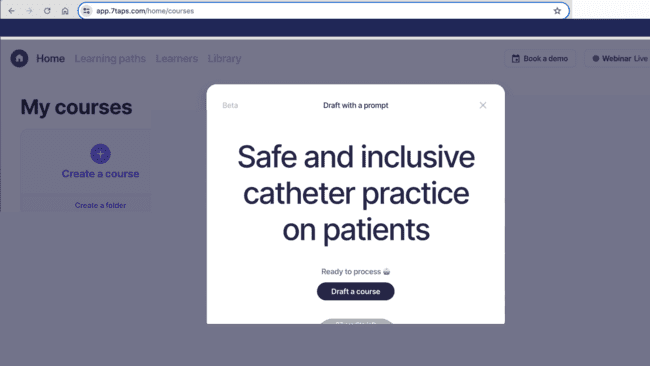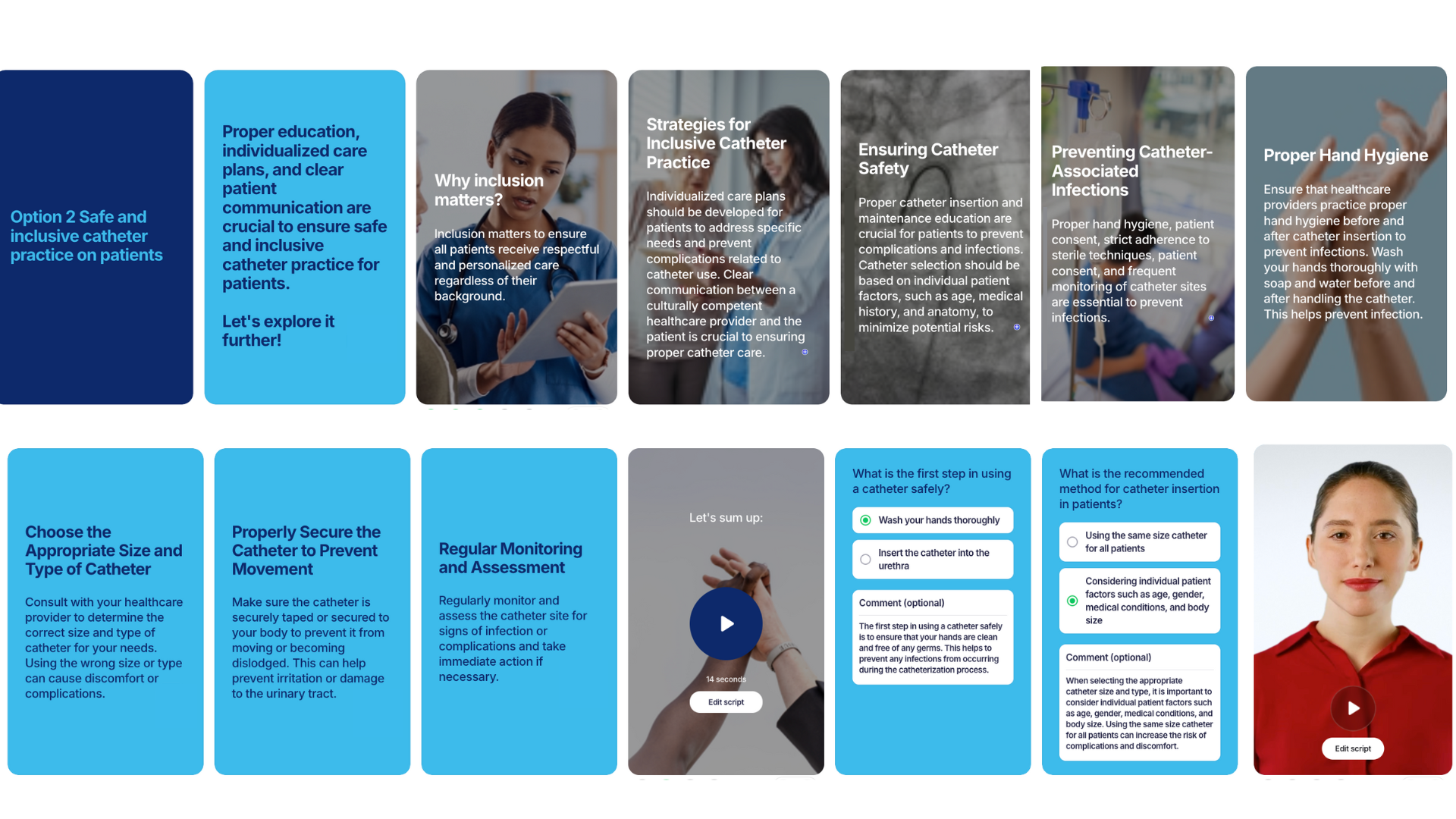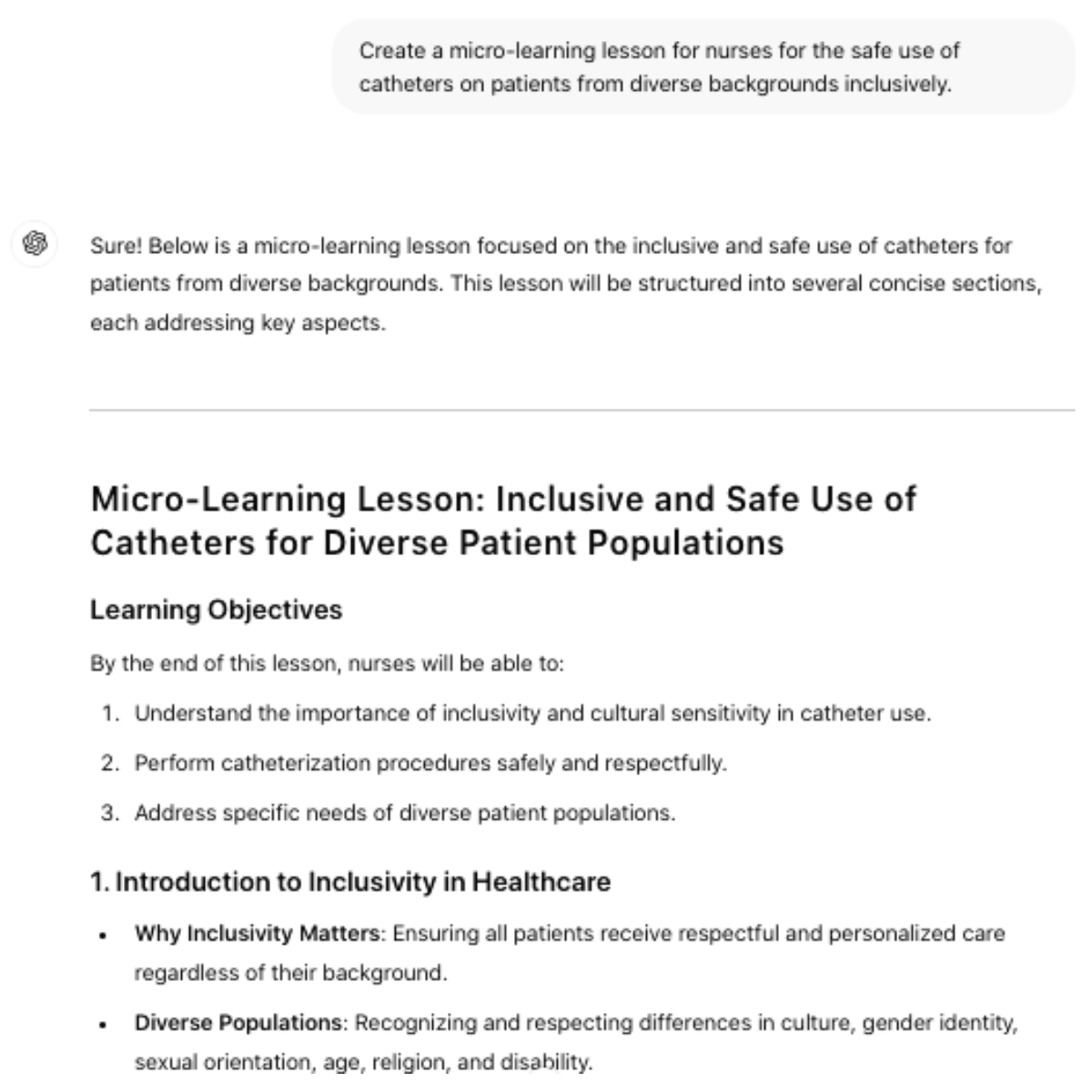This study investigates the integration of systems thinking and action research methodologies into creating AI-driven educational content with a primary focus on promoting inclusive and equitable learning experience design. In action research, the researcher uses generative AI tools like Chat-GPT, a tool enabling natural language conversations with advanced artificial intelligence from OpenAI, and the AI feature of a micro-learning course authoring tool, 7Taps, to design and develop learning experiences using an iterative approach. The data from the learning experience is gathered to gain insight, develop reflective practice, effect positive changes in the learning practices, and improve the learning outcomes and the lives of those involved for a more equitable learning experience (Gay et al., 2017). Drawing from the foundational concepts of systems thinking, the study examines the intricate relationships among learners, educators/learning professionals, instructional technology, and broader socio-cultural contexts within an organization’s ecosystems. Moreover, systems thinking can identify, analyze, and challenge the systems of power and design interventions and strategies for promoting social justice and liberation (Pal, 2023). This holistic perspective serves as a foundation for the subsequent integration of action research principles, enabling iterative, participatory content creation cycles. The study emphasizes the active involvement of diverse stakeholders, including educators, instructional designers, learning professionals, learners, and team member resource group representatives, in shaping the development of AI-driven educational learning content.
Artificial Intelligence (AI) and, specifically, the subset of the AI ecosystem in recent times, Generative AI have emerged as transformative technologies across various sectors, with significant implications for education and designing learning experiences. Artificial Intelligence (AI) constitutes a robust and evolving ecosystem comprising diverse subfields, each contributing to technological progress. Generative AI, a subset of the AI ecosystem, involves creating new content, data, or patterns through algorithms, often based on deep learning techniques, including text and media like images and music, based on the data it has been trained on (Henke, 2024). The field of generative AI has been greatly influenced by the emergence of groundbreaking tools such as OpenAI's ChatGPT, Microsoft CoPilot, and Google Gemini. These tools have significantly impacted the advancement of AI technology and have the potential to revolutionize various industries. In the context of adult learning in healthcare education, AI and Generative AI offer powerful tools to enhance both medical and soft skills training. The integration of AI in medical education may facilitate personalized learning experiences, real-time feedback, and the simulation of complex clinical scenarios, thereby improving the competency and readiness of healthcare professionals (Wartman & Combs, 2018). However, the potential of AI and Generative AI to enhance equitable and inclusive learning design by removing barriers to access and participation requires additional study. Further research into generative AI tools can contribute to identifying and mitigating biases in educational materials and assessments, fostering a fair learning environment where all students can thrive.
This study utilized an action research framework to iteratively develop AI-driven learning experiences, leveraging systems thinking to contextualize AI applications in a healthcare setting. Participants included instructional designers, educators, and learners, who offered insights into the inclusivity and accessibility of the generated content. Generative AI tools, Chat-GPT and 7Taps, were employed to create microlearning modules, emphasizing equitable, just-in-time content creation for healthcare professionals. Feedback from participants was collected through narrative inquiry, where unstructured interviews captured reflective responses, guiding iterative cycles of design and improvement.
In the first phase of the study, participants were asked to share their initial thoughts about generative AI within the socio-cultural contexts of the healthcare organization system. The narrative inquiry revealed a mix of positive and negative reflections. Based on the participants' reflections and learning needs, a microlearning experience about the safe use of catheter practice was designed using the 7Taps generative AI feature to test the efficiency of the generative AI tool. This initiative was grounded in an action research methodology, incorporating a systems thinking approach. As depicted in Figure 1, the initial prompt was a straightforward and broad statement: "How to use a catheter safely?" This prompt was intentionally simple to evaluate the AI tool's baseline performance. It did not include context, specificity, persona, or keywords such as inclusive practices and critical components in creating effective healthcare education materials.
Figure 1
A prompt to generate a microlearning experience on the 7Taps tool.

As shown in Figure 2, a prompt generated the learning experience using the 7Taps authoring tool's generative AI feature. The majority of participants did not identify any specific misinformation in the learning content; however, they noted a lack of inclusion of context, specificity, or keywords related to inclusive catheter practice in patients. They also felt that the information about catheter use was quite basic.
Figure 2
Microlearning is generated by the generative AI feature of the 7Taps tool.

After analyzing the feedback, a new prompt, as shown in Figure 3, was drafted to generate a new learning experience. This prompt was concise and direct in generating microlearning to address the need for safety and inclusivity in catheter practice. Furthermore, specific keywords were added, highlighting two critical aspects—safety and inclusivity—crucial in catheter practice. The prompt also added persona, i.e., patients.
Figure 3
A second iteration of the prompt to generate a microlearning experience

Participants were then asked to provide their reflections and recommendations about the second iteration of the microlearning experience, as shown in Figure 4. Most participants felt the content generated had no specific misinformation about catheterization practice and liked the mention of the inclusive practices that can improve the patient experience. They found some of the images relevant to the learning content; however, they saw little diversity in the images of people. Participants felt that although the learning design and content were better than the previous design, they still needed more context, specificity, and in-depth procedures that could enhance the application with patients.
Figure 4
A second iteration of microlearning generated by the generative AI feature of the 7Taps.

By this time, it was observed that the quality of the prompt had a significant impact on modifying the behavior of the outcome. Furthermore, 7Taps was limited to using 50 characters to generate learning design output. Hence, a new tool was included to use the prompts to generate better content outcomes using Chat-GPT. The objective was to enhance the learning design initially generated by the 7Taps tool and build upon it to address the core concerns and feedback received from the participants. As shown in Figure 5, the new prompt is configured with detailed instructions on the researcher's background, topics, and accessibility for improved accuracy. Guidelines on tone, goals, and a low-temperature setting (0–0.3) minimize misinformation(GPT Workspace, n.d.). The revised prompt, "Create a micro-learning lesson for nurses on the safe use of catheters with inclusivity," incorporated six key components: context, relevance specificity, conciseness, persona, and keywords. Participant feedback and National Library of Medicine validation ensured accuracy and alignment with learning goals (Haider & Annamaraju, 2023).
Figure 5
A revised prompt to generate a microlearning experience on Chat-GPT.

In this third iteration, participants were asked to provide their reflections and recommendations regarding the microlearning experience, as shown in Figure 6. This iteration incorporated content generated by Chat-GPT into the existing learning design created by 7Taps. In response to participant feedback, images on several slides were modified to enhance diversity, equity, and inclusion (DEI), improving content comprehension and representation. This approach aligns with Universal Design for Learning (UDL) principles, which emphasize providing multiple means of representation and engagement to cater to diverse learners (CAST, n.d). Most participants found the third iteration informative and meaningful. The safe catheterization procedure was clearly explained, resulting in a significant learning outcome, while inclusive practices were explicitly highlighted with images that fostered a new understanding.
Figure 6
An excerpt of the third iteration of microlearning generated by the generative AI feature Chat-GPT and 7Taps.

Early participation feedback highlighted limitations in specificity, cultural sensitivity, and diversity in AI-generated content, raising concerns about misrepresentation and misinformation. It led to iterative refinements in AI prompt design, incorporating context, specificity, and keywords to better align with diverse healthcare needs. Further refinements addressed the depth of information, adding inclusive practices tailored for varied patient demographics. By iterating prompts and integrating stakeholder feedback, a more comprehensive microlearning experience was developed. For instance, Chat-GPT generated content on safe and inclusive catheter practices, considering cultural sensitivities. This approach provided a nuanced learning experience that resonated with learners’ needs and reinforced inclusive practices. Participant feedback revealed that action research feedback loops helped address gaps in representation and depth of content, leading to a more robust micro-learning experience. This feedback guided updates in visual diversity, allowing the learning modules to better reflect healthcare’s multicultural workforce. The use of Universal Design for Learning (UDL) principles facilitated accessible, engaging content that catered to diverse learning preferences. During the action research phases, it was observed that well-tailored prompts significantly influence the quality of the AI's response. Participant feedback also emphasized the need for continuous auditing, data triangulation, and bias reduction in AI-generated learning materials. As shown in Figure 7, it is recommended to incorporate these six components: context, relevance, specificity, conciseness, persona, and keywords for generating more precise, relevant, and beneficial outputs for learning design experiences. Furthermore, adjust AI settings (role, tone, accessibility, temperature) to align with ethical and inclusive educational content generation, and use formal review processes integrating learner feedback and expert validation to address ethical considerations.
Figure 7
A new tailored prompt framework for generating learning content and design.

The integration of systems thinking and action research with generative AI tools has demonstrated significant potential in advancing inclusive learning designs in healthcare education. Iterative cycles guided by diverse stakeholder feedback, this study the critical role of ethical AI use, well-structured prompt frameworks, and continuous feedback loops in ensuring AI-generated content remains accurate and inclusive. Further research should explore scalable frameworks that mitigate biases and ethical considerations for inclusive educational AI-driven content generation.